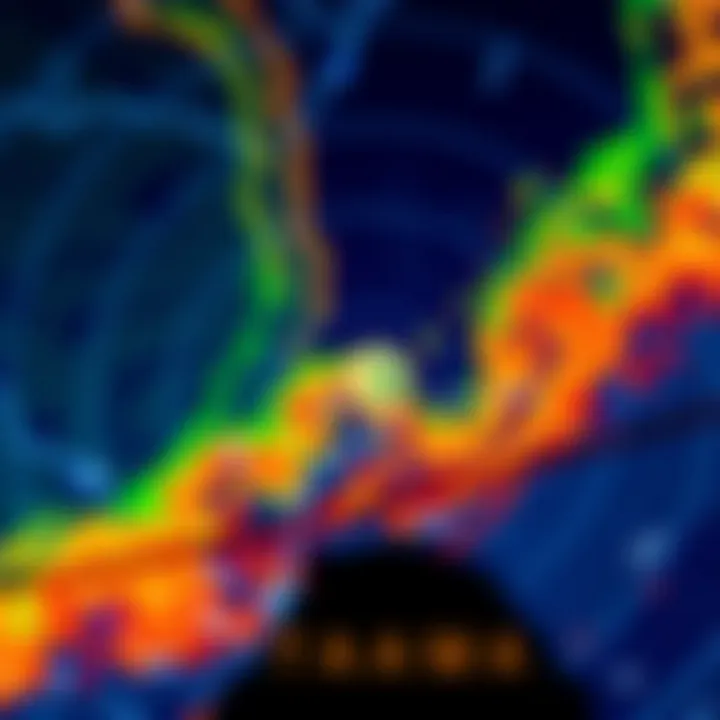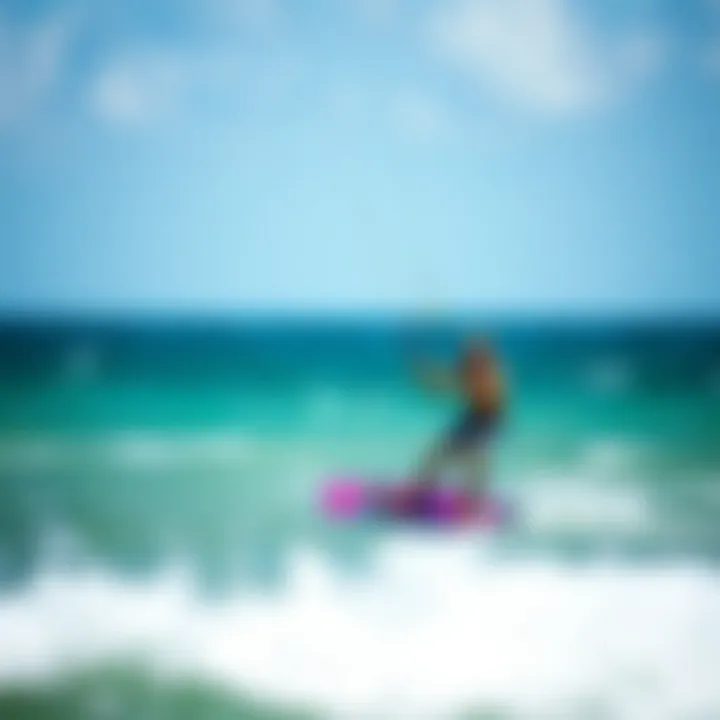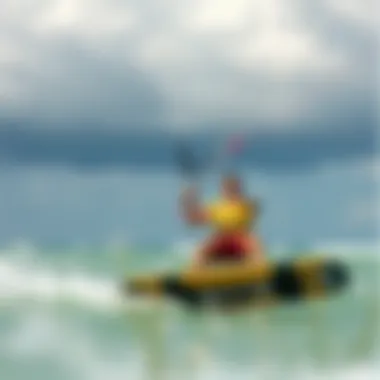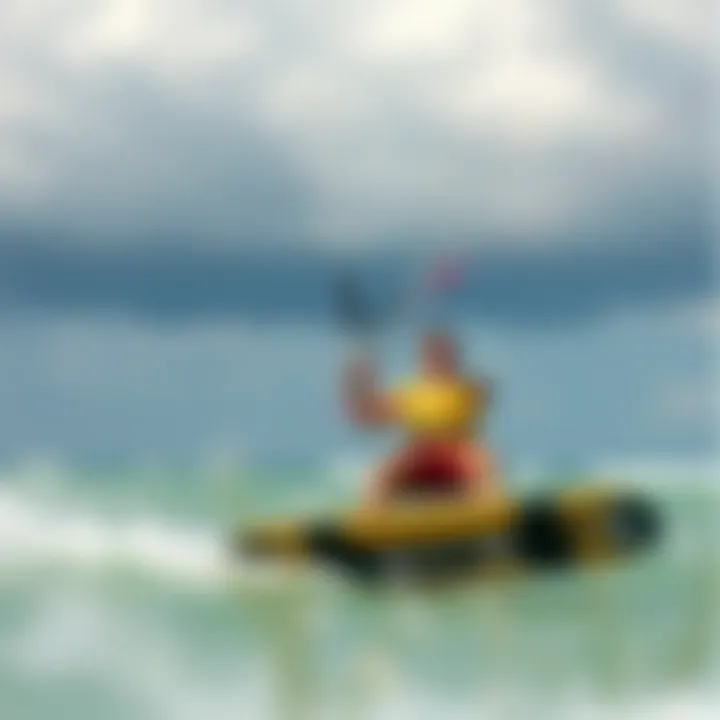Understanding Weather Channel Radar in Tampa


Intro
Tampa, with its sprawling coastlines and vibrant kiteboarding scene, is a haven for adventure seekers. But, as any seasoned kiteboarder knows, staying safe and making the most of the wind involves more than just skill on the board. It hinges on understanding the weather, especially the intricacies of radar information provided by the Weather Channel. This article dives into how the Weather Channel radar operates in Tampa, its significance for predicting weather conditions, and how it intertwines with the exciting world of kiteboarding.
Understanding weather patterns is much like mastering a complex dance; every twist and turn yields crucial insights, making a significant difference between a thrilling ride and a perilous outing. As we explore the radar technology's role in Tampa, we aim to bridge the gap between meteorological data and practical kiteboarding decisions.
The synergy between local weather dynamics and kiteboarding is essential, especially in a place like Tampa, where weather can change faster than you can say "let's catch the wind!" This comprehensive guide will enlighten you not only on how to interpret radar data effectively but also on the tools you’ll want to have in your kit to enhance your experience on the waters.
Understanding Weather Radar Technology
In today's fast-paced world, understanding weather radar technology is of prime importance, especially for kiteboarders and outdoor adventurers who thrive on real-time weather insights. This section aims to unravel the intricacies of radar systems, shedding light on how they function and why they're essential for anticipating weather patterns in Tampa and beyond.
What is Weather Radar?
Weather radar is a specialized tool developed to evaluate atmospheric conditions by sending out radio waves. When these waves hit objects—like raindrops or hail—they bounce back to the radar, which interprets the data to create a visual map of precipitation and storm activity. This dynamic enables meteorologists to paint a detailed picture of what’s brewing in the sky.
But it doesn't stop here; modern weather radar can also capture information on wind direction and speed, enhancing its utility beyond just identifying rainfall. It becomes a multi-functional device critical for pilots, boaters, and kiteboarding practitioners who need precise weather data.
The Science Behind Radar Operations
Radar technology rests on fundamental principles of physics. The basic premise involves sending out signals and evaluating what comes back; sort of like throwing a ball and waiting to see how it bounces off walls. This process can get pretty complex, utilizing Doppler effect to measure movement within storm systems. The radar can differentiate between static objects and those in motion, so it can tell if storm fronts are brewing or moving in a certain direction.
This capability is pivotal for making short-term weather predictions. For instance, if the radar detects a fast-moving system approaching Tampa, kiteboarders can adjust their plans accordingly—either to enjoy the wind or stay safely ashore.
Types of Weather Radar Systems
Not all weather radars are created equal. Various systems serve different purposes, each boasting unique features and capabilities.
- Doppler Radar: Primarily used by meteorologists, this type tracks wind speed and rain intensity, providing real-time data on storm systems.
- Dual-Polarization Radar: This advanced system improves precipitation identification by sending and receiving pulses both vertically and horizontally. It helps in understanding storm composition, crucial for predicting severe weather events.
- Phased Array Radar: An innovative type, allowing rapid scanning of the atmosphere, making it ideal for tracking fast-moving storms in real-time.
By understanding the different types of radar technology, kiteboarders and outdoor enthusiasts can make informed decisions about when to take to the waters and when to heed caution. This knowledge not only enhances safety but also enriches the experience of enjoying the great outdoors.
"Knowledge is power, especially when it comes to safety in unpredictable weather conditions."
Overall, grasping the basics of weather radar technology is vital for anyone in Tampa, be it locals or visitors. From planning kiteboarding sessions to ensuring personal safety, this understanding serves as a cornerstone for enjoying the vibrant Tampa weather.
The Weather Channel's Radar in Tampa
Understanding how The Weather Channel's radar operates in Tampa is not just a matter of curiosity; it has practical ramifications for everyday activities, particularly for kiteboarders, instructors, and anyone else who relies on accurate weather data. The unique climatic environment in Tampa, often marked by sudden weather changes, makes this technology especially critical for precise forecasting and informed decision-making.
The radar system provides crucial insights into the atmospheric conditions that shape the local weather landscape. Here, we'll break down some of these elements in greater detail, examining the continually evolving nature of Tampa's weather.
Overview of Tampa's Weather Patterns
Tampa experiences a humid subtropical climate, characterized by hot summers and mild winters. The radar is instrumental in tracking these conditions, which can shift dramatically in a matter of moments. Here are some key elements that define Tampa's weather:
- Thunderstorm Activity: During the summer months, Tampa frequently encounters thunderstorms. The radar helps identify storm development and intensity, providing real-time updates.
- Hurricane Season Tracking: From June to November, the radar becomes vital in monitoring hurricane activity over the Gulf of Mexico, aiding in preparations and evacuations if necessary.
- Daily Temperature Variations: The ability to predict temperature changes throughout the day can influence various outdoor activities, including kiteboarding.
Understanding these patterns is essential, especially for enthusiasts who want to maximize their time on the water while minimizing risks. The information drawn from the radar provides a detailed and nuanced view of daily and seasonal weather trends in Tampa.
Unique Features of Tampa's Radar Data


Tampa's Weather Channel radar is notable for several unique features that enhance its usability:
- High Resolution Imaging: The radar technology offers remarkably detailed imagery, allowing users to see specific weather conditions within localized areas. This is particularly helpful in spotting microclimates that can affect kiteboarding spots.
- Real-Time Updates: Unlike some older systems, the Weather Channel’s radar provides real-time refresh rates. This immediacy is crucial for kiteboarders who need to adapt quickly to changing conditions.
- Integration with Community Reports: The data is often augmented by reports from local kiteboarders and weather enthusiasts, creating a rich tapestry of information that can reflect on-the-ground conditions more accurately than technology alone.
"The Weather Channel radar is not just a tool; it's a lifeline for kiteboarders navigating Tampa’s unpredictable waters."
These distinctive features make it an essential resource not only for kiteboarders but also for the general public who wish to stay informed about weather conditions. Understanding and leveraging this information can help individuals minimize hazards while enjoying the natural beauty of Florida's coastline.
Applications of Radar in Weather Forecasting
Weather radar systems play a pivotal role in forecasting and understanding climatic patterns, especially for areas like Tampa, where the weather can change on a dime. The applications of radar in weather forecasting are numerous, contributing significantly to safer and more informed decisions for kiteboarders and other outdoor enthusiasts. Understanding these applications can enhance not only the knowledge of local weather but also support safety and planning.
Real-Time Weather Monitoring
Real-time weather monitoring is arguably one of the most important applications of weather radar technology. With the capabilities offered by the Weather Channel's radar system, users in Tampa can access up-to-the-minute data on precipitation, storm movements, and even temperature changes. This immediacy is crucial for anyone engaging in outdoor activities.
The radar provides a visual representation of weather patterns through colored imagery showing storms, rain, and other phenomena. For example, a radar image displaying heavy rain could prompt kiteboarders to reconsider their plans for the day. Radar can detect impending storms hours ahead of their arrival, allowing individuals to make informed choices regarding safety. Here’s how to efficiently utilize this data:
- Check Radar Regularly: Frequent updates from the radar allow users to keep track of shifting conditions.
- Understand Radar Imagery: Familiarizing oneself with common indicators in radar images can aid in quick decision-making during impromptu weather changes.
- Utilize Weather Apps: Many local applications integrate radar data from Weather Channel, giving users easy access on their smartphones.
"Weather can shift quicker than you can say kiteboarding! Leveraging radar insights helps prevent unnecessary risks."
Predicting Severe Weather Events
Another significant aspect to consider in the applications of radar is predicting severe weather events. Tampa’s climate, with its potential for sudden thunderstorms and tropical disturbances, can pose challenges, particularly for those taking part in water sports. These conditions can develop rapidly, but with the advanced technology available today, severe weather warnings can often be issued well in advance.
Radar systems help in identifying not just the occurrence of storms but also their development trajectory. This predictive power is invaluable:
- Severe Thunderstorm Warnings: Radar can delineate areas of heavy rainfall and potentially dangerous winds, crucial for kiteboarders navigating busy waters.
- Hurricane Monitoring: Given Tampa’s susceptibility to hurricanes, radar tracks not only storm positioning but also intensity. This information is vital in planning evacuation or rescheduling kiteboarding trips.
- Lightning Detection: One of the unsung features is the ability to indicate lightning threat zones, letting kiteboarders know when it’s best to stay on land.
Integrating these insights into daily routines can significantly enhance safety and preparedness. By becoming familiar with how radar delivers relevant data, especially regarding severe weather events, individuals can enjoy the adventurous spirit of kiteboarding without undue risk.
Kiteboarding: The Intersection of Weather and Sport
Kiteboarding blends the thrill of surfing with the excitement of flying. It’s a sport that thrives on wind, sun, and sea. Understanding how various weather elements play into kiteboarding is not merely beneficial; it's essential for safety and performance. In Tampa, where weather conditions can change in the blink of an eye, kiteboarders must grasp the nuances of local meteorological patterns. This knowledge can mean the difference between an exhilarating ride and a dangerous day on the water.
Influence of Weather on Kiteboarding Conditions
The relationship between weather and kiteboarding is profound. The winds, temperature, and precipitation all influence the kiteboarding experience.
- Wind Speed and Direction: Kiteboarding relies on wind as its lifeblood. The ideal conditions typically range from 12 to 25 knots. Too little wind can leave you marooned on the water, while too much can turn a fun session into a struggle against the elements. In Tampa, the prevailing southeasterly winds can be a kiteboarder's best friend, especially during the spring and summer months when breezes often pick up in the afternoons.
- Temperature Variations: Temperature can also play a critical role in kiteboarding. Warmer months may bring consistent wind patterns, but the discomfort of soaring temperatures can be challenging. Staying hydrated and taking breaks in shaded areas can enhance both performance and safety.
- Rainfall and Storms: Showers and thunderstorms are not uncommon in Tampa, particularly in the summer months. Sudden downpours can significantly affect visibility and safety on the water. Monitoring radar data in real-time can alert kiteboarders to impending storms, allowing them to make informed decisions while planning their sessions.
"Kiteboarding is not just about riding the wind; it’s about knowing the wind."
Understanding Wind Patterns Through Radar Data
Radar technology is an invaluable tool for kiteboarders looking to interpret wind patterns effectively. It offers detailed insights into wind speed and direction, which are critical for navigation on water.
- Live Data Analysis: Weather Channel radar provides real-time updates, displaying wind direction and intensity over various geographical locations. This information is vital for kiteboarders before heading out, as it can help in choosing the best launch sites and times.
- Predicting Conditions: Radar data can assist kiteboarders in tracking changes in wind patterns. By observing how the wind behaves throughout the day, kiteboarders can make strategic decisions about when and where to kite. Understanding these patterns can also allow enthusiasts to, quite literally, chase the wind when conditions are most favorable.
Moreover, kiteboarding instructors can leverage radar data to teach newcomers about the intricacies of wind dynamics. A practical demonstration of how wind shifts affect kiting can solidify theoretical knowledge and enhance safety on the water.
In summary, the intersection of weather and kiteboarding in Tampa is a rich field that requires a keen understanding of local weather patterns, particularly wind dynamics. Harnessing radar data not only aids in making informed, safe choices but also contributes to a more rewarding experience overall.


Safety Considerations for Kiteboarders
Kiteboarding is not just an exhilarating sport; it hinges significantly on understanding and respecting the weather. In Tampa, with its unique weather patterns, kiteboarders must prioritize safety to enjoy their time on the water fully. The implications of being aware of weather conditions can spell the difference between a thrilling experience and a hazardous situation. To navigate these waters safely, here are two critical aspects to consider.
Monitoring Weather Changes
Weather can flip faster than a switch, especially in coastal areas prone to sudden storms or gusty winds. Therefore, monitoring changes in weather is paramount for kiteboarders. By staying attuned to updates from the Weather Channel's radar, kiteboarders can track the movements of storms and shifting wind shifts effectively.
- Radar Updates: Make it a habit to check the radar before heading out. The Weather Channel radar provides real-time updates on rain, wind speed, and other significant metrics.
- Mobile Applications: Download weather apps that offer alerts. Imagine being on your board and suddenly realizing the storm rolling in behind you – not a great picture. Having alerts set can save time and lives.
Utilizing community updates can also prove beneficial. Engaging with local kiteboarding forums on platforms like Reddit can offer real-time insights from other kiteboarders who may be observing conditions firsthand.
Planning Kiteboarding Sessions Safely
Planning your kiteboarding sessions involves more than just picking a spot; it requires a strategic approach to the day's weather elements. Understanding how factors such as tide, wind direction, and visibility impact your kiteboarding can make all the difference.
- Choose the Right Time: Aim for times when winds are gentle and the weather stable. Early mornings can often present calmer conditions, while afternoons may bring onshore breezes.
- Know Your Limits: As conditions fluctuate, adjust your plans accordingly. If the forecast warns of gusty winds or impending rain, it might be wise to postpone.
- Educate Yourself: Familiarizing yourself with local weather patterns helps in making informed decisions. Tampa’s summer storms can be unpredictable, and knowing how they behave can guide your plans.
Always err on the side of caution. The ocean is beautiful, but it can be unforgiving. Stay updated and prepared to ensure an exciting and safe kiteboarding adventure.
By incorporating these safety measures and understanding the dynamics of local weather, kiteboarders can greatly enhance their experiences while prioritizing their safety.
Using Weather Channel Radar Effectively
Using the Weather Channel radar effectively can drastically alter how kiteboarders in Tampa approach their sport. Understanding local weather patterns, speed of wind, and potential storms is essential for safe and enjoyable kiteboarding experiences. Getting a grip on the radar data equips enthusiasts with the tools needed to make informed decisions. These decisions can be the difference between a thrilling day out on the water and a potentially hazardous situation.
Accessing Real-Time Data
To make the most of the Weather Channel radar, accessing real-time data is key. Kiteboarders should familiarize themselves with the Weather Channel app or website which provides up-to-the-minute updates tailored to their region. Here’s how the process can be simplified:
- Download the App: Having the Weather Channel app on your mobile device means you can view live weather updates anytime.
- Set Your Location: Ensure that your location is set to Tampa so that the radar data is relevant. This gives you information tailored to your immediate surroundings.
- Check Radar Animation: The animated radar feature allows users to see how weather patterns evolve over time. This is invaluable for predicting short-term changes.
- Look for Alerts: Pay attention to alerts shown on the radar, which could signify severe weather approaching. Being informed means you can plan your kiteboarding sessions around any dangerous weather, or even postpone if needed.
Utilizing real-time data empowers kiteboarders to stay ahead of sudden shifts in weather.
Interpreting Radar Images
Once you've accessed the radar data, the next step is interpreting radar images accurately. The images can sometimes look like a colorful mess of different shades, so here's a quick breakdown:
- Colors Matter: Generally, lighter colors indicate less intense precipitation, while darker colors can signify heavier rain or storms. Understanding this color code helps in gauging storm intensity.
- Watch Out for Patterns: When viewing the radar, look for patterns or trends in the movement of weather systems. Are they coming from the east or west? This knowledge can provide foresight on where weather may arrive next.
- Cross-reference Information: Don’t rely solely on radar images. It’s crucial to cross-check with other weather sources. Websites like NOAA and National Weather Service can provide additional context and forecasts.
"Effective reading of radar can mean the difference between a thrilling day and a day spent stuck indoors."
By learning to interpret radar images, kiteboarders can react more swiftly and adjust their plans accordingly. This is not just about safety but also about maximizing enjoyment on the water, ensuring that every session is as exhilarating as it can be. With tools like the Weather Channel radar, knowledge truly becomes power in the hands of those who venture out onto Tampa's vibrant waters.
Integration of Community Insights
Community insights play a pivotal role in understanding and utilizing the Weather Channel radar effectively for kiteboarding enthusiasts in Tampa. The integration of local perspectives and experiences adds layers of knowledge that raw data from radar systems alone cannot provide. This section discusses how collaboration among kiteboarders and sharing weather experiences enhances safety, planning, and overall enjoyment of the sport.
Collaboration Among Local Kiteboarders
When kiteboarders work together, they create a network of support that is invaluable, especially in a place like Tampa where weather conditions can shift unexpectedly. Local kiteboarders often have firsthand knowledge about specific areas, wind patterns, and tide conditions that aren't always visible on radar. For example, while radar might indicate a storm brewing in one area, a seasoned local can inform others that a particular spot tends to get windier or calmer as the storm approaches.
- Benefits of Collaboration:


- Enhanced Safety: By sharing real-time conditions and forecasts, kiteboarders can avoid hazardous situations.
- Skill Development: Local meet-ups often lead to skill exchanges, where experienced kiteboarders mentor newbies, fostering a supportive community.
- Resource Sharing: Many local riders may own different types of gear which they can showcase during group outings, allowing others to try new equipment before investing.
By utilizing radar data in conjunction with local knowledge, kiteboarders can refine their understanding of optimal times to hit the water, all while staying within safe parameters.
Sharing Weather Experiences
Sharing weather experiences within the kiteboarding community can transform individual knowledge into collective wisdom. Many kiteboarders turn to social media platforms, such as Facebook groups or forums like Reddit, to discuss weather patterns, wind speed, and water conditions observed over the years. This exchange of information ensures that the entire community remains informed.
For instance, an individual may post about wind conditions on a specific day, prompting discussions that could lead to discovering patterns that influence kiteboarding conditions.
"Real-time feedback from fellow kiteboarders not only anticipates weather surprises but also builds a tighter knit community that values safety and shared experiences."
Key Points in Sharing Weather Experiences:
- Community Alerts: Quick messages about sudden weather changes or unusual patterns can help everyone prepare or adjust plans promptly.
- Historical Data: The aggregation of these experiences forms an informal yet significant archive of kiteboarding weather conditions in the Tampa region.
- Event Planning: When local events are organized, knowledge from previous experiences helps in setting suitable dates and venues that align with favorable weather conditions.
In summary, the integration of community insights into the use of Weather Channel radar is essential for enhancing safety and enjoyment while kiteboarding in Tampa. Local kiteboarders not only rely on technology but also harness each other's experiences to make informed decisions, fostering a robust community that thrives under shared knowledge.
Future Trends in Weather Radar Technology
Exploring the future trends in weather radar technology is essential for anyone interested in weather tracking—especially kiteboarders in Tampa. As storms roll in and out, having accurate and up-to-date information can make all the difference. Improvements in radar tech not only enhance forecasting abilities but also significantly contribute to safety in water sports, which is critical in a region known for its turbulent weather patterns.
Advancements in Radar Capabilities
Recent advancements in radar capabilities have been nothing short of revolutionary. New technologies are emerging to improve resolution and precision in weather tracking. One such innovation is phased-array radar, which offers faster and more detailed information than traditional systems. This technology can continuously scan the atmosphere, providing a wealth of real-time data that is crucial for timely action.
The integration of machine learning algorithms into radar systems can analyze vast amounts of data and predict weather conditions with higher accuracy. For example, localized storm cells can be identified sooner, which is vital when planning kiteboarding sessions.
Additionally, the implementation of dual-polarization radar is becoming more common. This type of radar emits signals that can determine not just where precipitation is occurring but also what type it is—such as rain, snow, or even hail. Such insights allow users to make better-informed decisions about whether to hit the water or wait out a storm.
"The evolution of radar technology keeps us ahead of the storm, providing critical information for both recreational activities and safety measures."
Potential Impacts on Kiteboarding
The implications of these advancements for kiteboarding are significant. With improved radar, kiteboarders can gain access to granular weather data that was previously unattainable. Knowing the precise wind conditions in Tampa’s varying microclimates can save practitioners from diving into less-than-ideal situations.
Moreover, the enhanced predictive capabilities mean that users will receive earlier warnings about potential severe weather. This can prevent dangerous scenarios, enabling the kiteboarding community to focus on enjoying the sport while staying safe.
As more kiteboarders begin to rely on accurate and timely weather information, it could foster a culture of safety and awareness in the Tampa area. The far-reaching effects of these technologies could lead to collaborations among local kiteboarding enthusiasts, who can share their insights and experiences for the benefit of others.
In summary, the future of weather radar technology is not just about better forecasts—it's about creating a safer environment for those who seek adventure in the winds and waves of Tampa.
Epilogue
The conclusion of this article serves not merely as a summary but as a clarion call to appreciate the intricate relationship between weather radar technology and the various activities it impacts, particularly kiteboarding in Tampa. This intersection of technology and outdoor adventure is profound because it enhances not only our ability to predict weather conditions but also shapes our approach to safety and enjoyment in sports. The Weather Channel radar system stands as a cornerstone of this synergy, offering up-to-date, reliable data that informs decisions for kiteboarders, adventurers, and local residents alike.
Recap of Key Points
In revisiting the highlights of this exploration, we note several key areas:
- Understanding Weather Radar Technology: We delved into the fundamentals of weather radar, explaining how it captures and translates atmospheric data into meaningful information.
- Specifics of Tampa's Weather Patterns: Unique features of the local climate were discussed, illuminating how they affect kiteboarding dynamics and what the radar can tell us about imminent changes.
- Real-Time Weather Monitoring and Safer Planning: The need for continuous and accurate weather monitoring was emphasized, spotlighting how it enables safer planning for recreational activities.
- Community Collaboration: Insights from local kiteboarders, drawn together through shared experiences, enhance the understanding of weather implications for the sport.
The Importance of Weather Awareness
Having a keen sense of weather patterns is indispensable—not just for kiteboarders but for anyone who engages with the outdoors. The ability to anticipate sudden changes can mean the difference between a fantastic day on the water and a potential hazard. This awareness allows individuals to take proactive steps, ensuring that they are equipped for varying conditions, utilizing the Weather Channel radar as a reliable guide.
Emphasizing weather awareness cultivates a culture of safety and preparedness, ultimately enriching the kiteboarding experience.
"Weather is unpredictable, but with the right tools, we can navigate it better and enjoy every ride, no matter what Mother Nature throws our way."















